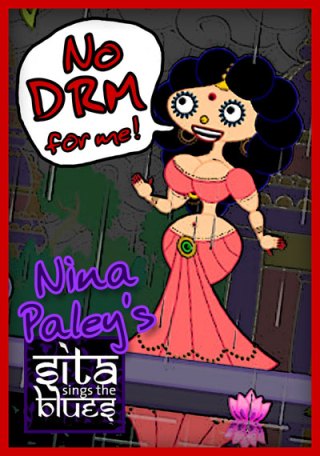DAY against DRM: Video
Posted by Laurel L. Russwurm on May 4, 2010
[Note: The subject is Video… sorry, it just occurred to me that folks may come her looking to see video rather than discuss it.]
 Tuesday May 4th has been designated the Day Against DRM by the Free Software Foundation.
Tuesday May 4th has been designated the Day Against DRM by the Free Software Foundation.
“Today is about taking time out of your usual routine to speak out in favor of a DRM-free society. We do not have to accept a future where our interactions with computers and published works are monitored and controlled by corporations or governments.”
Most people don’t know what DRM is, even if they’ve heard of it. Yet it is becoming an ever more prevalent component in our electronics, which are in turn becoming ever more prevalent in our lives.
DRM stands for digital rights management.
“Digital rights management (DRM) is a generic term for access control technologies that can be used by hardware manufacturers, publishers, copyright holders and individuals to impose limitations on the usage of digital content and devices. The term is used to describe any technology that inhibits uses of digital content not desired or intended by the content provider. The term does not generally refer to other forms of copy protection which can be circumvented without modifying the file or device, such as serial numbers or keyfiles. It can also refer to restrictions associated with specific instances of digital works or devices. Digital rights management is used by companies such as Sony, Apple Inc., Microsoft, AOL and the BBC.
The use of digital rights management is controversial. Proponents argue it is needed by copyright holders to prevent unauthorized duplication of their work, either to maintain artistic integrity[1] or to ensure continued revenue streams.[2] Some opponents, such as the Free Software Foundation, maintain that the use of the word “rights” is misleading and suggest that people instead use the term digital restrictions management. Their position is essentially that copyright holders are restricting the use of material in ways that are beyond the scope of existing copyright laws, and should not be covered by future laws.[3] The Electronic Frontier Foundation, and other opponents, also consider DRM systems to be anti-competitive practices.[4]”

I don’t have (and won’t have) a Kindle, for many reasons, but the Kindle provided one of the most ironic DRM stories. In the mistaken belief that George Orwell’s masterwork 1984 was in the public domain, Amazon released it as a Kindle book. Many people bought it. As it turned out, the book wasn’t in the public domain, so Amazon utilized their ability to access the Kindles of the people who had “purchased” the ebook and summarily removed them. People who hadn’t finished reading their copy suddenly no longer had one. People who had utilized the Kindle’s annotation feature lost their annotations with the ebook. Amazon did reimburse their customers. It was after all an honest mistake on their part; they had not known the book was not really in the public domain. But what this episode clearly illustrates is that the Kindle that people pay hundreds of dollars for, as well as the ebooks that they purchase from Amazon, are not under their own control.
If you were one of these customers who purchased the Kindle ebook reader and ebook, Amazon utilized their DRM capability to reach inside your Kindle and take back the ebook you had purchased in good faith.
ownership
Clearly, there is a failure to communicate. When we buy something, we believe we own it. The person or company we paid should no longer have any right to the product. They certainly should not have the right to come into our homes and take back the product we have purchased.
But DRM exists to allow the seller to control the product, and how we use the product, even after we have paid for it.
No one actually comes out and tells us in the store that we are buying goods that have been deliberately crippled with DRM.
If they did, customers might not buy them. But there is no ambiguity with retailers– they tell us they are selling us things, and we believe we are buying them.
But apparently the concepts of property ownership that have been prevalent in our society for centuries have suddenly changed. Yet people, customers, consumers have not been told about this. But we need to know about it. We need to understand it. And we need to give our informed consent.
But manufacturers, retailers and governments are not discussing it with us.
Over the past decade or so, instead of explaining to consumers that the rules of buying and selling have changed manufacturers have just been quietly putting DRM on products that we purchase. It is easier for them to cripple the technology than try to explain that they’ve changed the rules. After all, if customers know that the rules have changed, the very natural question is: what do we get out of it? The unfortunate answer to that is “shafted”.
video DRM
The first time I heard about DRM, it wasn’t called DRM, it was called “copy protection”. I heard that the Disney corporation had developed a method of preventing customers from copying the pre-recorded Disney video tapes. At the time, video was state of the art, and no one else was copy protecting movies. As near as I can figure it, the process made the signal of the video tapes too weak to copy well. There is just enough power to play on a television, but the signal strength was too weak to make copying possible. This copy protection was ostensibly to prevent bootlegging. The funny thing is, it didn’t. Although consumers are prevented from making a back-up copy of the movie they purchased, bootleggers always have state of the art equipment to get around DRM.
Although I never tried dubbing any of the Disney movies that I bought for my family, I came to this realization that this is roughly how VHS copy protection DRM works when I started copying my home movie video tapes onto DVDs on a VHS to DVD burner. If there are glitches in the video signal, or dropout, or “snow”, when I am copying video tapes the recording abruptly ends, the machine stops dubbing and notifies me that I do not have the right to copy this material. This is particularly infuriating because I certainly do have the right to copy my own home movies I have made onto my own DVDs.
computer DRM
My sister had a similar problem with her first VISTA computer. It would not allow her to copy photographs she’d taken of her own family onto her own computer, because VISTA believed she was infringing copyright.
DVD DRM
When video tape first came out, North American video tapes were recorded in NTSC and European tapes were recorded in PAL. This was a way to address the physical problem of different television technology. This was necessary because broadcast signal and the scan lines in television sets varied. Because we were already used to the fact that videotapes were different in different regions, I know I never questioned the idea that there would be region restrictions for DVDs.
But I’ve since learned that there is no physical reason for DVDs to have regional restrictions. This is another form of DRM. If I live in Canada, and purchase hundreds of DVDs, then move to Sweden, all of my DVDs would be worthless. So I would have to purchase them all over again.
cel phone DRM
We bought a set of family cel phones, but although the phones had many really great capabilities, they had been locked down and crippled, so that the customer was forced to do everything through the retailer’s website (very expensive). We returned them and went with a different company.
There are more DRMed products every day. Consumers must begin to tell manufacturers and governments “No DRM.”
Sita Sings the Blues: No DRM

Filmmaker Nina Paley made a wonderful animated film using very old sound recordings that were clearly in the public domain. But big media “copyright reforms” have changed things so radically –by retroactively extending the copyright term which should have ended and placed the recordings in the public domain in the 1980’s– that somebody owns the particular rights – “synch rights” — which you need when using recorded music in a film. ”
The long and the short of it is that Nina Paley would have to pay had to pay gigantic sums of money in order to acquire these rights and release her film. Another alternative would be have been to throw out the film (a couple of years worth of classical animation). She instead decided to:
“pay $50,000 in license fees and another $20,000 in legal costs to make it so. That is why I am in debt. …
“Having paid these extortionate fees, I could have gone with conventional distribution, and was invited to. I chose to free the film because I could see that would be most beneficial to me, my film, and culture at large. A CC-SA license does not absolve a creator of compliance with copyright law. The law could have sent me to prison for non-commercial copyright infringement. I was forced to borrow $70,000 to decriminalize my film, regardless of how I chose to release it.
—Nina Paley, CORRECTION
chose the radical course of releasing her film under a creative commons license.
You can download the movie for free on Nina’s website: Sita Sings the Blues
You can learn more about the distribution at the Question Copyright “Sita Sings the Blues” Distribution Project
Just recently Nina Paley was offered an opportunity to distribute Sita on the American streaming site Netflix, who refused to run her film without their standard DRM. You can read all about it on Nina’s blog Although the money would have been helpful in paying off the film’s outstanding debt, Nina Paley turned Netflix down for ethical reasons.
Nina Paley believes that strongly that DRM is bad.
image credit: “No DRM for Me!” is a remix of part of this image from Nina Paley’s wonderful animated film “Sita Sings the Blues”.
A higher resolution version of this re:mix 4×6 mini-poster is available here: http://russwurm.org/bulletin/images/NOdrmFORme.jpg
For more links about Day Against DRM blogs posts and activities from all over the world, visit http://groups.fsf.org/wiki/Group:Day_Against_DRM_2010



 windows7sins.org
windows7sins.org


2012 International Day Against DRM « techDITZ said
[…] Day Against DRM article I wrote in 2010 explains my problem with […]
C-11 ~ Canadians Don’t Know From TPMs « Laurel L. Russwurm said
[…] first Day Against DRM was in 2010. And May 4th — Friday next week — is this year’s “International Day […]
Nina Paley said
Thanks! Some important facts in your post about me and “Sita” are incorrect. Would you please correct them?
http://blog.ninapaley.com/2009/07/29/correction/
Thanks again,
–Nina
Laurel L. Russwurm said
Sorry for the inaccuracies. I made the cardinal error of relying on memory (I should know better) when I ought to have checked the facts. Mea culpa.
Thank you for the wonderful film “Sita Sings the Blues”.
Nina Paley said
Yay! I know it’s a complicated story – like all stories about navigating our Kafka-esque copyright system. Thanks for updating the post.